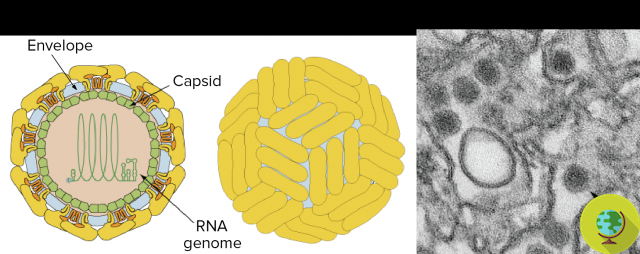
Zika virus, there are still too many doubts and questions that scientists and epidemiologists around the world are asking about this strain. The first even concerns the connection between the virus and microcephaly, still questioned. But there is a new shadow surrounding the infamous virus. It is that of GMOs, considered a remedy for some but for others even the cause of the spread of the mosquito
Don't store avocado like this: it's dangerous
Zika virus, there are still too many i doubts and the questions scientists and epidemiologists around the world are asking about this strain. The first even concerns the connection between the virus and microcephaly, still questioned. But there is a new shadow. It is that of GM, for some considered a remedy but for others even the cause of the spread of the mosquito.
This is a very complex story that must be treated with the utmost caution and which starts from search for solutions to counter the spread of this virus, transmitted by the zanzara Aedes aegypti. This insect with its bites can transmit various viral agents, such as dengue, chikungunya, yellow fever and "Zika disease".
In the past, drastic solutions such as the use of GMO insects. And the name associated with this practice is above all that of Oxytec. According to some scientists, genetically modified mosquitoes offer a controversial solution to control the spread of certain diseases. The British company Oxytec has the patent of sterile GMO mosquito designed to counteract A. Aegypti. By mating with the females, they do not produce any offspring. The virusZika instead it is a trademark of ATCC.
Un Claire Bernish article published last week in AntiMedia draws attention to an interesting aspect of the question passed over in silence: the correlation between the incidence of Zika and release zone for genetically modified organisms of Aedes aegypti mosquitoes to counteract yellow fever.
It is not known whether this is a case, but in February 2015 the Brazilian authorities began studying a outbreak of skin rashes which had affected six states in the north-east region of the country. According to the Pan American Health Organization, 20 countries reported cases of Zika in their territories: Barbados, Bolivia, Brazil, Colombia, Ecuador, El Salvador, Guadalupe, Guatemala, Guyana, French Guiana, Haiti, Honduras, Martinique, Mexico, Panama, Paraguay, Puerto Rico, the island of St. Maarten, Suriname and Venezuela.
The GMO experiment was described in July 2015 in the journal PLoS Neglected Tropical Diseases. 30.000 GMO mosquitoes were first released between May and June 2011, followed by largest release of 540.000 mosquitoes per week the first months of 2012.
Last year in January, the Smithsonian's Tropical Research Institute (STRI) ne spoke already in terms of a not so perfect solution. While modifying mosquitoes seemed like a good compromise to experts, in the long run this may not have been a good idea at all.
The team then advanced the hypothesis that competition between these mosquitoes could affect the success of the strategy more sophisticated on their part. Oxitec has focused its efforts on dengue and has also had some success in Brazil and the Cayman Islands. In April 2014, Oxitec led by the Gorgas Institute of Panama released 60.000 genetically modified A. aegypti mosquitoes in Arraijá. By October, scientists saw a more than 90 percent reduction in the local mosquito population in Panama, according to results published by Oxitec.
But Smithsonian Tropical Research Institute scientist Matt Miller speculated that Asian tiger mosquitoes might have replace A. aegypti in areas where GMO programs had killed the local population of mosquitoes. The result? All to be ascertained.
There are also those who, like prof. of Biology of Notre Dame Alex Perkins, supports the opposite. The GMO solution would be a blessing, not a curse. When asked about the alleged correlation between GMOs and Zika, he said that nothing could be further from the truth.
“It is possible that genetically modified mosquitoes are one of the most important tools we have to fight Zika. If anything, we should be able to figure out how to use more of them ”.
Many hypotheses, very few confirmations. Second la Whorld Health Organization, anche the relationship between Zika virus infection and birth defects and neurological syndromes has not yet been established, even if it is suspicious. For this the WHO called a meeting of the Emergency Committee, which took place on 1 February. On that occasion, it was only confirmed that the search on the new foci of microcephaly and other neurological disorders it should be intensified to determine if there is a causal link with the Zika virus and other factors or co-factors.
"Since these clusters have been observed in areas recently infected with the Zika virus, and in line with good public health practices and in the absence of another explanation, the Committee stresses the importance of aggressive measures to reduce Zika virus infection, especially for pregnant women and women of childbearing age " recommended la WHO.
The only thing we can do, for now, is to know how to protect ourselves. Here you are what to do if you have to go abroad.
Francesca Mancuso
READ also:
THE ZIKA VIRUS ARRIVES IN EUROPE: WHAT IT IS, SYMPTOMS AND TREATMENT
VIRUS ZIKA: WHAT YOU MUST DO WHO GOES ABROAD (AND NOT ONLY)
MICROCEPHALIA EPIDEMIC AMONG INFANTS IN BRAZIL: THE FAULT OF A VIRUS TRANSMITTED BY MOSQUITOES?


























